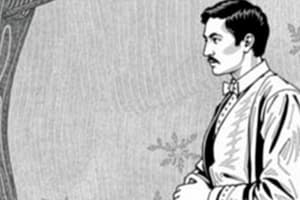Podcast
Questions and Answers
How did Harriet Beecher Stowe's 'Uncle Tom's Cabin' influence Rizal?
How did Harriet Beecher Stowe's 'Uncle Tom's Cabin' influence Rizal?
- It led Rizal to prepare a novel depicting the miseries of Filipinos under Spanish rule. (correct)
- It prompted Rizal to study the conditions of Negro slaves in America.
- It encouraged Rizal to write about American slave-owners.
- It inspired Rizal to become a medical student.
What is the significance of the title 'Noli Me Tangere'?
What is the significance of the title 'Noli Me Tangere'?
- It is a reference to Rizal's personal experiences in Madrid.
- It refers to a chapter in the Gospel of Luke about healing.
- It is a quote from a famous Spanish philosopher.
- It is a Latin phrase meaning 'Touch Me Not,' taken from the Gospel of St. John. (correct)
Which character in 'Noli Me Tangere' embodies the suffering of the motherland?
Which character in 'Noli Me Tangere' embodies the suffering of the motherland?
- Maria Clara
- Pia Alba
- Doña Victorina
- Sisa (correct)
Which of the following best describes the relationship between Padre Salvi and Maria Clara?
Which of the following best describes the relationship between Padre Salvi and Maria Clara?
Which character in 'El Filibusterismo' is a journalist who believes himself to be the only one thinking in the Philippines?
Which character in 'El Filibusterismo' is a journalist who believes himself to be the only one thinking in the Philippines?
What is the main difference between the protagonists Ibarra in Noli Me Tangere and Simoun in El Filibusterismo?
What is the main difference between the protagonists Ibarra in Noli Me Tangere and Simoun in El Filibusterismo?
What is the significance of Rizal dedicating 'El Filibusterismo' to Gomburza?
What is the significance of Rizal dedicating 'El Filibusterismo' to Gomburza?
What best explains why Elias helped Ibarra despite Ibarra's family having oppressed Elias' family for generations?
What best explains why Elias helped Ibarra despite Ibarra's family having oppressed Elias' family for generations?
How does Doña Victorina symbolize aspects of Philippine society during Rizal's time?
How does Doña Victorina symbolize aspects of Philippine society during Rizal's time?
How does Kapitán Tiago contribute to the social commentary in the novels?
How does Kapitán Tiago contribute to the social commentary in the novels?
Why was Rizal forced to delete the chapter about Elias and Salome from 'Noli Me Tangere'?
Why was Rizal forced to delete the chapter about Elias and Salome from 'Noli Me Tangere'?
What are the key distinctions between 'Noli Me Tangere' and 'El Filibusterismo' according to Rizal?
What are the key distinctions between 'Noli Me Tangere' and 'El Filibusterismo' according to Rizal?
What is Simoun's primary motivation for planning a revolution in 'El Filibusterismo'?
What is Simoun's primary motivation for planning a revolution in 'El Filibusterismo'?
How does Pilosopo Tasyo's character contribute to the themes explored in 'Noli Me Tangere'?
How does Pilosopo Tasyo's character contribute to the themes explored in 'Noli Me Tangere'?
In 'El Filibusterismo,' how does Basilio’s character evolve from his portrayal in 'Noli Me Tangere'?
In 'El Filibusterismo,' how does Basilio’s character evolve from his portrayal in 'Noli Me Tangere'?
How does Rizal use the character of Padre Damaso to critique aspects of Spanish colonial rule?
How does Rizal use the character of Padre Damaso to critique aspects of Spanish colonial rule?
How does the character of Juli (Juliana de Dios) in 'El Filibusterismo' highlight the social issues of the time?
How does the character of Juli (Juliana de Dios) in 'El Filibusterismo' highlight the social issues of the time?
Who financed the printing of Noli Me Tangere after Rizal faced financial difficulties?
Who financed the printing of Noli Me Tangere after Rizal faced financial difficulties?
Which character in 'El Filibusterismo' sabotaged Simoun's revolutionary plans by throwing the lamp into the river?
Which character in 'El Filibusterismo' sabotaged Simoun's revolutionary plans by throwing the lamp into the river?
What was Capitan Tiago's primary source of wealth?
What was Capitan Tiago's primary source of wealth?
Flashcards
El Filibusterismo
El Filibusterismo
Rizal's sequel to Noli Me Tangere; his second complete novel
Uncle Tom's Cabin
Uncle Tom's Cabin
Novel by Harriet Beecher Stowe that inspired Rizal
Noli Me Tangere
Noli Me Tangere
The title of Rizal's first novel, meaning 'Touch Me Not'
Crisostomo Ibarra
Crisostomo Ibarra
Signup and view all the flashcards
Maria Clara
Maria Clara
Signup and view all the flashcards
Padre Damaso
Padre Damaso
Signup and view all the flashcards
Kapitan Tiago
Kapitan Tiago
Signup and view all the flashcards
Pilosopo Tasyo
Pilosopo Tasyo
Signup and view all the flashcards
Elias
Elias
Signup and view all the flashcards
Doña Victorina
Doña Victorina
Signup and view all the flashcards
Sisa
Sisa
Signup and view all the flashcards
Isagani
Isagani
Signup and view all the flashcards
Quiroga
Quiroga
Signup and view all the flashcards
Father Florentino
Father Florentino
Signup and view all the flashcards
Gobernador General
Gobernador General
Signup and view all the flashcards
Study Notes
- Jose Rizal wrote 8 novels, including 6 unfinished and untitled works, and 2 published novels.
Unfinished and Untitled Novels
- One unfinished novel has 44 pages in Rizal's handwriting, the manuscript is preserved in the National Library, and the hero is Kamandagan.
- Makamisa is a Tagalog novel with only two finished chapters in a 20-page manuscript.
- There is a novel written in ionic Spanish during Rizal's exile in Dapitan; it consists of 8 pages.
- Life in Pili, Laguna is an unfinished Spanish novel with 147 pages, including characters such as Pedro Agaton, and Cecilia.
- Cristobal is an untitled novel about a young Filipino student returning from Europe.
- One novel is written in two notebooks, with the first containing 31 pages and the second containing 12 pages.
- Harriet Beecher Stowe's "Uncle Tom's Cabin" inspired Rizal to write a novel about the suffering of Filipinos under Spanish rule.
Noli Me Tangere
- Work on Noli Me Tangere started in Madrid in 1884, with Rizal finishing about half of it.
- Rizal completed half of the second half in Paris in 1885 while studying at the Universidad Central Madrid.
- He finished the last fourth in Germany, and the last few chapters were written in Wilhelmsfeld in April-June 1886.
- Viola financed the printing due to Rizal's lack of funds
- Rizal and Viola supervised the printing of Noli, proofreading the pages, and the novel was released on March 21, 1887.
- Rizal sent the first copies to Blumentritt, Antonio Ma. Regidor, and others.
- On March 29, 1887, Rizal gave Viola the galley proofs of Noli out of gratitude.
- "Noli Me Tangere" means "Touch Me Not" and comes from the Gospel of St. John.
Attackers and Defenders of the Noli
- Fr. Jose Rodriguez published pamphlets to discredit Noli.
- Father Font distributed copies to discredit the same controversial novel.
- Vicente Barrantes criticized Noli in an article published in "La España Moderna" in January 1890.
- Marcelo H. Del Pilar, Antonio Ma. Regidor, and others defended the Noli.
Important Characters in the Noli
- The novel features nine important characters.
- Crisostomo Ibarra is a Filipino-Spanish descendant of Don Rafael Ibarra, who spent seven years studying in Europe.
- Maria Clara is the primary female character, daughter of Capitán Tiago and Doña Pia Alba, raised under the guidance of T Isabel.
- Padre Damaso is a Franciscan friar and former curate of San Diego, known for being snobbish and ruthless.
- Kapitán Tiago is the son of a wealthy trader, who became a servant of a Dominican priest.
- Filósofo Tacio is referred to as a philosopher/sage or an imbecile depending on the views of the townspeople.
- Elias is from a family oppressed by the Ibarra clan who becomes indebted to Ibarra.
- Doña Victorina pretends to be a mestiza and marries Don Tiburcio.
- Sisa is married to Pedro and is the mother of Basilio and Crispin who goes lunatic searching for her children after they go missing.
- Doña Consolacion is the wife of the Alferez and used to be a laundry woman.
Representation of Noli Characters
- Crisostomo Ibarra symbolizes the idealism of the privileged youth.
- Elias represents the common Filipino and is said to be the personification of Andres Bonifacio.
- Kapitan Tiago symbolizes the rich Filipinos who oppress their fellow countrymen.
- Maria Clara symbolizes the purity and innocence of a sheltered native woman.
- Doña Victorina symbolizes those with a distorted view of their identity.
- Don Tiburcio represents the ignorant Spaniards.
- Pia Alba represents the women abused by the clergy and silenced by their shame.
- Gobernador General represents the typical Governor Generals who disregarded the power of the friars.
- Alfonso Linares represents the young Spaniards seeking a better life in the Philippines.
- Alferez Dona Consolascion's husband represents the officials with power struggles with Church officials.
- Pilosopo Tasyo symbolizes the learned Filipinos and is a pessimist.
- Padre Hernando Sibyla symbolizes the liberal friar.
- Padre Bernardo Salvi manipulates people, harboring lust for Maria Clara.
- Padre Damaso symbolizes the Spanish friars of Rizal's time.
- Sisa personifies the suffering of the motherland.
- Basilio and Crispin represent the innocent who were wrongly accused of crimes
- Doña Consolacion symbolizes the Filipinos ashamed of their own race and nationality.
Conditions and Problems of Philippine Society
- Noli Me Tangere conveys the suffering of Filipinos under Spanish colonization.
- Rizal perceived Noli as a reflection of the social, moral, and political life of his time, depicting the need for redemption from bondage and repression.
El Filibusterismo
- Rizal deleted the Elias and Salome chapter because it was an economic decision.
- After arriving in Ghent, Belgium, Rizal chose the F. Meyer Van Loo Press for printing El Filibusterismo.
- Valentin Ventura provided financial help to resume printing the book.
- Rizal dedicated the novel to Gom-Bur-Za.
- The original manuscript of El Filibusterismo is preserved in the National Library.
Characters of El Filibusterismo
- Simoun Crisostomo Ibarra resurfaces as a wealthy jeweler seeking revenge.
- Basilio, the son of Sisa, is a graduating medical student who befriends Simoun.
- Isagani is Basilio's friend who sabotaged Simoun's plans to start a revolution.
- Kabesang Tales resurfaces as the feared bandit Matanglawin.
- Don Custodio is a journalist who married a rich woman to be part of Manila's high society.
- Paulita Gómez is the girlfriend of Isagani who marries Juanito Peláez.
- Tiburcio de Espadana ends up with Juanito Pelaez and is no longer with Isagani.
- Macaraig is one of Isagani's classmates and the leader of the student.
- Father Florentino is Isagani's godfather and a secular priest.
- Huli is the girlfriend of Basilio, who eventually commits suicide.
- Juanito Pelaez is a favorite student of the professors who marries Paulita.
- Doña Matutinay is Tiburcio de Espadaña's wife in Noli Me Tangere.
- Father Camorra is the lustful parish priest of Tiani
- Ben-Zayb is a journalist who believes he is the "only" one thinking in the Philippines.
- Placido Penitente is a student who did not wanted to pursue his studies.
- Hermana Penchang is Sagpang's rich gambler who offers Juli to be her maid.
- Tiburcio de Espadaña is hiding at Father Florentino's.
- Father Irene helped the students establish the Academia de Castellano so Basilio will obtain nothing from the inheritance.
- Quiroga is a Chinese businessman.
- Don Timoteo Pelaez is Juanito's father and a rich businessman.
- Tano raised the sick and young Basilio after he left their house.
- Father Fernández promised the students would get what they demand.
- Sandoval coerces his classmates to lead the Spanish student academy.
- Hermana Bali became full's figure and counselor: helped to release Kabesang Tales
- Father Millon is a Physics friar professor.
- Tadeo, along with the other three members of their gang, supposedly posted the posters.
- Leeds is an American who holds stage plays.
- Tano became a civil guard.
- Pepay is Don Custodio's "girlfriend".
- Gobernador General prioritizes the needs of his fellow Spaniards.
- Father Hernando de la Sibyla is a Dominican friar.
- Pecson suggested that they held the mock celebration
- Father Bernardo Salvi is a parish priest
- Captain Tiago disintegrated by smoking opium
Major Theme of Fili
- El Filibusterismo is a more revolutionary and tragic sequel to Noli Me Tangere.
- Padre Florentino was based on Father Leoncio Lopez, Isagani on Vicente Ilustre, and Paulita Gomez on Leonor Rivera.
Comparison of Noli and Fili
- Noli is a romantic novel, while Fili is a political novel.
- Noli is a "book of the heart," while Fili is a "book of the head."
- Fili consists of 38 chapters, whereas Noli has 64 chapters.
- Noli and Fili demonstrate the actual and real conditions of the Philippines and the sufferings of the Filipinos during the Spanish rule.
- Both novels were instrumentals in awakening the spirit of Filipino nationalism
Rizal's Dedication of the Fili to GOMBURZA
- The novel is dedicated to the memory of priests Don Mariano Gomez, Don Jose Burgos, and Don Jacinto Zamora executed in Bagumbayan Field on February 28, 1872.
Studying That Suits You
Use AI to generate personalized quizzes and flashcards to suit your learning preferences.




